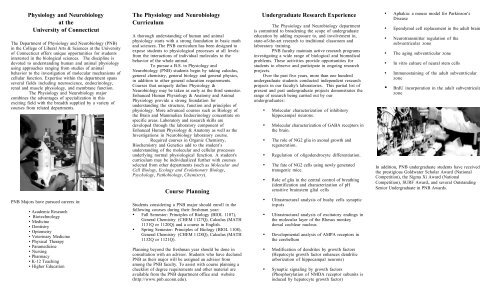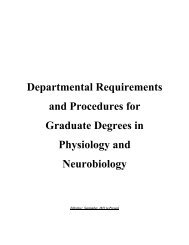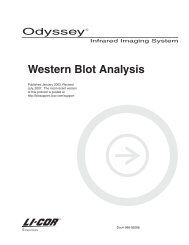Download our brochure to learn more about Physiology ...
Download our brochure to learn more about Physiology ...
Download our brochure to learn more about Physiology ...
You also want an ePaper? Increase the reach of your titles
YUMPU automatically turns print PDFs into web optimized ePapers that Google loves.
<strong>Physiology</strong> and Neurobiology<br />
at the<br />
University of Connecticut<br />
The Department of <strong>Physiology</strong> and Neurobiology (PNB)<br />
in the College of Liberal Arts & Sciences at the University<br />
of Connecticut offers unique opportunities for students<br />
interested in the biological sciences. The discipline is<br />
devoted <strong>to</strong> understanding human and animal physiology<br />
using approaches ranging from studies of animal<br />
behavior <strong>to</strong> the investigation of molecular mechanisms of<br />
cellular function. Expertise within the department spans<br />
several fields including neuroscience, endocrinology,<br />
renal and muscle physiology, and membrane function.<br />
The <strong>Physiology</strong> and Neurobiology major<br />
combines the advantages of specialization in this<br />
exciting field with the breadth supplied by a variety of<br />
c<strong>our</strong>ses from related departments.<br />
The <strong>Physiology</strong> and Neurobiology<br />
Curriculum<br />
A thorough understanding of human and animal<br />
physiology starts with a strong foundation in basic math<br />
and sciences. The PNB curriculum has been designed <strong>to</strong><br />
expose students <strong>to</strong> physiological processes at all levels:<br />
from the interactions of individual molecules <strong>to</strong> the<br />
behavior of the whole animal.<br />
To pursue a B.S. in <strong>Physiology</strong> and<br />
Neurobiology (PNB) students begin by taking calculus,<br />
general chemistry, general biology and general physics,<br />
in addition <strong>to</strong> other general education requirements.<br />
C<strong>our</strong>ses that uniquely define <strong>Physiology</strong> &<br />
Neurobiology may be taken as early as the third semester.<br />
Enhanced Human <strong>Physiology</strong> & Ana<strong>to</strong>my and Animal<br />
<strong>Physiology</strong> provide a strong foundation for<br />
understanding the structure, function and principles of<br />
physiology. More advanced c<strong>our</strong>ses such as Biology of<br />
the Brain and Mammalian Endocrinology concentrate on<br />
specific areas. Labora<strong>to</strong>ry and research skills are<br />
developed through the labora<strong>to</strong>ry component of<br />
Enhanced Human <strong>Physiology</strong> & Ana<strong>to</strong>my as well as the<br />
Investigations in Neurobiology labora<strong>to</strong>ry c<strong>our</strong>se.<br />
Required c<strong>our</strong>ses in Organic Chemistry,<br />
Biochemistry and Genetics add <strong>to</strong> the student’s<br />
understanding of the molecular and cellular processes<br />
underlying normal physiological function. A student's<br />
curriculum may be individualized further with c<strong>our</strong>ses<br />
selected from other departments (such as Molecular and<br />
Cell Biology, Ecology and Evolutionary Biology,<br />
Psychology, Pathobiology, Chemistry).<br />
C<strong>our</strong>se Planning<br />
Undergraduate Research Experience<br />
The <strong>Physiology</strong> and Neurobiology department<br />
is committed <strong>to</strong> broadening the scope of undergraduate<br />
education by adding exposure <strong>to</strong>, and involvement in,<br />
state-of-the-art research <strong>to</strong> traditional classroom and<br />
labora<strong>to</strong>ry training.<br />
PNB faculty maintain active research programs<br />
investigating a wide range of biological and biomedical<br />
problems. These activities provide opportunities for<br />
students <strong>to</strong> observe and participate in ongoing research<br />
projects.<br />
Over the past five years, <strong>more</strong> than one hundred<br />
undergraduate students conducted independent research<br />
projects in <strong>our</strong> faculty's labora<strong>to</strong>ries. This partial list of<br />
present and past undergraduate projects demonstrates the<br />
range of research being carried out by <strong>our</strong><br />
undergraduates:<br />
• Molecular characterization of inhibi<strong>to</strong>ry<br />
hippocampal neurons.<br />
• Molecular characterization of GABA recep<strong>to</strong>rs in<br />
the brain.<br />
• The role of NG2 glia in axonal growth and<br />
regeneration.<br />
• Regulation of oligodendrocyte differentiation.<br />
• The fate of NG2 cells using newly generated<br />
transgenic mice.<br />
• Role of glia in the central control of breathing<br />
(identification and characterization of pH<br />
sensitive brainstem glial cells<br />
• Aphakia: a mouse model for Parkinson’s<br />
Disease<br />
• Ependymal cell replacement in the adult brain<br />
• Neurotransmitter regulation of the<br />
subventricular zone<br />
• The aging subventricular zone<br />
• In vitro culture of neural stem cells<br />
• Immunostaining of the adult subventricular<br />
zone<br />
• BrdU incorporation in the adult subventricular<br />
zone<br />
In addition, PNB undergraduate students have received<br />
the prestigious Goldwater Scholar Award (National<br />
Competition), the Sigma Xi Award (National<br />
Competition), SURF Award, and several Outstanding<br />
Senior Undergraduate in PNB Awards.<br />
PNB Majors have pursued careers in:<br />
• Academic Research<br />
• Biotechnology<br />
• Medicine<br />
• Dentistry<br />
• Op<strong>to</strong>metry<br />
• Veterinary Medicine<br />
• Physical Therapy<br />
• Paramedicine<br />
• Nursing<br />
• Pharmacy<br />
• K-12 Teaching<br />
• Higher Education<br />
Students considering a PNB major should enroll in the<br />
following c<strong>our</strong>ses during their freshman year:<br />
• Fall Semester: Principles of Biology (BIOL 1107),<br />
General Chemistry (CHEM 1127Q), Calculus (MATH<br />
1131Q or 1120Q) and a c<strong>our</strong>se in English.<br />
• Spring Semester: Principles of Biology (BIOL 1108),<br />
General Chemistry (CHEM 1128Q), Calculus (MATH<br />
1132Q or 1121Q).<br />
Planning beyond the freshman year should be done in<br />
consultation with an advisor. Students who have declared<br />
PNB as their major will be assigned an advisor from<br />
among the PNB faculty. To assist with c<strong>our</strong>se planning a<br />
checklist of degree requirements and other material are<br />
available from the PNB department office and website<br />
(http://www.pnb.uconn.edu).<br />
• Ultrastructural analysis of bushy cells synaptic<br />
inputs<br />
• Ultrastructural analysis of excita<strong>to</strong>ry endings in<br />
the molecular layer of the Rhesus monkey<br />
dorsal cochlear nucleus<br />
• Developmental analysis of AMPA recep<strong>to</strong>rs in<br />
the cerebellum<br />
• Modification of dendrites by growth fac<strong>to</strong>rs<br />
(Hepa<strong>to</strong>cyte growth fac<strong>to</strong>r enhances dendritic<br />
arborization of hippocampal neurons)<br />
• Synaptic signaling by growth fac<strong>to</strong>rs<br />
(Phosphorylation of NMDA recep<strong>to</strong>r subunits is<br />
induced by hepa<strong>to</strong>cyte growth fac<strong>to</strong>r)
PNB Faculty and their Research<br />
Interests<br />
Marie E. Cantino, Associate Professor, Ph.D., University<br />
of Washing<strong>to</strong>n. Molecular mechanisms regulating<br />
strength of contraction in skeletal and cardiac muscle<br />
William D. Chapple, Professor, Ph.D., Stanford. Reflex<br />
and postural control mechanisms used in arthropod<br />
movement<br />
Joanne Conover, Associate Professor, Ph.D., Bath<br />
University. Neural stem cell biology and its application<br />
in neurodegenerative disease.<br />
Joseph F. Crivello, Professor, Ph.D., University of<br />
Wisconsin. Molecular and biochemical impact of aquatic<br />
pollutants on marine organisms<br />
Angel L. de Blas, Professor, Ph.D., Indiana University.<br />
Molecular structure and function of neurotransmitter<br />
recep<strong>to</strong>rs<br />
Robert V. Gallo, Professor, Ph.D., Purdue. Regulation of<br />
pulsatile luteinizing hormone release during different<br />
physiological conditions<br />
Joseph J. Lo Turco, Professor, Ph.D., Stanford. Cellular<br />
and molecular mechanisms that direct the generation of<br />
neurons in the developing brain<br />
Andrew Moiseff, Professor, Ph.D., Cornell.<br />
Neuroethology of vertebrate and invertebrate sensory<br />
systems<br />
Daniel K. Mulkey, Assistant Professor; Ph.D., Wright<br />
State University. Cellular and molecular mechanisms by<br />
which the brain controls breathing.<br />
Akiko Nishiyama, Associate Professor, M.D., Ph.D.,<br />
Nippon Medical School & Niigata University.<br />
Development and function of glial cells in the brain<br />
J. Larry Renfro, Professor and Head, Ph.D., Oklahoma.<br />
Comparative physiology of os<strong>more</strong>gulation;<br />
transepithelial transport and excretion of environmental<br />
pollutants in tissues<br />
Maria E. Rubio, Associate Professor, M.D., Ph.D.<br />
University of Al icante & Institute of Neuroscience.<br />
Targeting mechanisms and distribution of recep<strong>to</strong>r<br />
channels in the central nervous system.<br />
Anastasios Tzingounis, Assistant Professor; Ph.D.,<br />
OHSU. The cellular and molecular basis of controlling<br />
neuronal excitability in the mammalian brain.<br />
Randall S. Walikonis, Associate Professor, Ph.D., Mayo<br />
Clinic. Molecular structure and signaling mechanisms of<br />
synapses<br />
Affiliated Faculty<br />
Lawrence E. Armstrong Professor (Kinesiology), Ph.D.,<br />
Ball State. Human physiological responses <strong>to</strong> exercise,<br />
dietary intervention, heat <strong>to</strong>lerance, and acclimatization<br />
<strong>to</strong> heat<br />
Ben A. Bahr, Associate Professor (Pharmaceutical<br />
Sciences) Ph.D., University of California, Santa Barbara.<br />
Drug discovery and mechanisms of neuroprotection in<br />
models of Alzheimer-type pathogenesis, stroke-related<br />
exci<strong>to</strong><strong>to</strong>xicity, and neuro<strong>to</strong>xin exposure.<br />
Thomas Chen, Professor (Molecular and Cell Biology),<br />
Ph.D., Alberta. Structure, evolution, regulation and<br />
molecular actions of growth hormone and insulin-like<br />
growth fac<strong>to</strong>r genes; regulation of foreign genes in<br />
transgenic fish; development of model transgenic fish<br />
William J. Kraemer, Professor/Direc<strong>to</strong>r of Research,<br />
(Neag School of Education). Research involves the study<br />
of the body's response and adaptations <strong>to</strong> resistance<br />
training from the cellular <strong>to</strong> the whole body levels.<br />
Carl M. Maresh, Professor and Head (Kinesiology),<br />
Ph.D., Wyoming. Neuroendocrine and substrate responses<br />
<strong>to</strong> exercise stress and training in humans<br />
Linda S. Pescatello, Professor (School of Allied Health),<br />
Ph.D., University of Connecticut. Acute and chronic<br />
hemodynamic responses <strong>to</strong> dynamic exercise as<br />
modulated by genetic and environmental influences.<br />
Steven A. Zinn, Professor (Animal Science), Ph.D.,<br />
Michigan State. Expression of growth fac<strong>to</strong>rs during<br />
development<br />
Adam Zweifach, Professor (MCB) Ph.D. Yale University.<br />
Signal transduction in immune cells<br />
Cover Pho<strong>to</strong>: Magnified surface of a pig kidney cell<br />
grown in tissue culture. A single cilium is surrounded<br />
by numerous microvilli. Pho<strong>to</strong>graphed by James<br />
Romanow of the University of Connecticut Electron<br />
Microscope Facility. C<strong>our</strong>tesy of J. L. Renfro.<br />
Additional Information<br />
Department of <strong>Physiology</strong> and Neurobiology<br />
75 North Eagleville Road, U-3156<br />
S<strong>to</strong>rrs, CT 06269-3156<br />
Telephone (860) 486-3305<br />
Fax (860) 486-3303<br />
WWW: http://www.pnb.uconn.edu<br />
Revised September 2008





